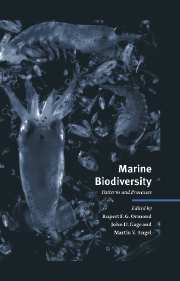Book contents
- Frontmatter
- Contents
- List of contributors
- Foreword: The value of diversity
- 1 Marine biodiversity in its global context
- 2 Gradients in marine biodiversity
- 3 Pelagic biodiversity
- 4 Biological diversity in oceanic macrozooplankton: More than counting species
- 5 Large-scale patterns of species diversity in the deep-sea benthos
- 6 Diversity, latitude and time: Patterns in the shallow sea
- 7 High benthic species diversity in deep-sea sediments: The importance of hydrodynamics
- 8 Diversity and structure of tropical Indo-Pacific benthic communities: Relation to regimes of nutrient input
- 9 Why are coral reef communities so diverse?
- 10 The biodiversity of coral reef fishes
- 11 The historical component of marine taxonomic diversity gradients
- 12 Population genetics and demography of marine species
- 13 Discovering unrecognised diversity among marine molluscs
- 14 Ecosystem function at low biodiversity – the Baltic example
- 15 Land–seascape diversity of the USA East Coast coastal zone with particular reference to estuaries
- 16 The development of mariculture and its implications for biodiversity
- 17 Protecting marine biodiversity and integrated coastal zone management
- 18 Conserving biodiversity in North-East Atlantic marine ecosystems
- Author index
- Species index
- Subject index
1 - Marine biodiversity in its global context
Published online by Cambridge University Press: 04 August 2010
- Frontmatter
- Contents
- List of contributors
- Foreword: The value of diversity
- 1 Marine biodiversity in its global context
- 2 Gradients in marine biodiversity
- 3 Pelagic biodiversity
- 4 Biological diversity in oceanic macrozooplankton: More than counting species
- 5 Large-scale patterns of species diversity in the deep-sea benthos
- 6 Diversity, latitude and time: Patterns in the shallow sea
- 7 High benthic species diversity in deep-sea sediments: The importance of hydrodynamics
- 8 Diversity and structure of tropical Indo-Pacific benthic communities: Relation to regimes of nutrient input
- 9 Why are coral reef communities so diverse?
- 10 The biodiversity of coral reef fishes
- 11 The historical component of marine taxonomic diversity gradients
- 12 Population genetics and demography of marine species
- 13 Discovering unrecognised diversity among marine molluscs
- 14 Ecosystem function at low biodiversity – the Baltic example
- 15 Land–seascape diversity of the USA East Coast coastal zone with particular reference to estuaries
- 16 The development of mariculture and its implications for biodiversity
- 17 Protecting marine biodiversity and integrated coastal zone management
- 18 Conserving biodiversity in North-East Atlantic marine ecosystems
- Author index
- Species index
- Subject index
Summary
Abstract
How important is marine biodiversity for understanding global biodiversity? This introductory chapter compares and contrasts marine with terrestrial (including freshwater) diversity by looking at the present state of knowledge and our ability to explain diversity patterns and richness.
Diversity is not only species number; phyletic, morphological, ecological and genetic diversity are important concepts, if difficult to measure satisfactorily. In phyletic diversity, marine systems are superior in the metazoa, inferior in green plants and fungi. Ecological diversity is probably the measure most needed, hardest to achieve and, for the moment, impossible to compare between sea and land. In species numbers, weak evidence suggests there are ten times as many multicellular terrestrial as marine species, but our ignorance, even in well-known areas, is great. In patterns, particularly the tropical–polar gradient, and in richness, terrestrial studies suggest that the nature of energy input, heterogeneity and specificity are all strongly involved. The detailed balance of different factors is undoubtedly different in different groups, and many factors are involved. The importance of heterogeneity and specificity in the sea is rightly a subject of active research.
In knowledge and in ignorance, marine studies are on a par with terrestrial. In academic activity and repute, marine studies are not given sufficient weight. The relatively low level of productivity of the sea and the differences in the scaling of heterogeneity may be important in the contrast with terrestrial systems.
- Type
- Chapter
- Information
- Marine BiodiversityPatterns and Processes, pp. 1 - 17Publisher: Cambridge University PressPrint publication year: 1997
- 8
- Cited by



